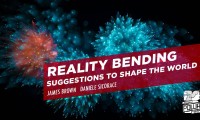Happy New Year everyone and welcome to 2015.
I had planned to write about this last year (like many things planned 🙂 ), however yesterday as I searched my house for something I suddenly remembered and thought I would do it as a 2015 kick off.
So last year I was looking into different ways you can influence someones memory, specifically to that of amnesia and forgetting the purpose / train of thought they were originally on. The thought process behind this is three fold really. Initially you have situations either in person or remotely where it may be advantageous to have someone forget why they were taking you somewhere, or who they were going to fetch (thing onsite engagement where you are caught), the same could potentially apply in phishing or vishing where you perhaps want someone to forget what drew them to a current conclusion, perhaps why they thought a topic or link was dodgy. Then finally for my other personal interests, how you could you utilise something like this for illusion / mentalism methods.
What I came across was a paper which is a few years old by Gabriel A. Radvansky, Sabine A. Krawietz, and Andrea K. Tamplin called “Walking through doorways causes forgetting:Further explorations“, it was taken from the 2011 Quarterly Journal Of Experimental Psychology.
You all know the situation, you reach for your house keys, wallet or phone, its not there. Where did you leave it? When did you last have it? You recount the steps and eventually you hit a part of the house and it clicks, you left them in the oven 🙂 Why who knows, but you remembered, you get the stuff and normal operations resume. In this paper, the researchers have acknowledged previous virtual experiments around memory decline in these scenarios, and taken it further with physical studies.
I encourage those interested to read the some of the information here, but essentially in the tests they ran they had individuals perform memory tasks. This could be remembering the colours of wooden blocks and going to another room, or picking up objects and taking them to another table in the same room or through a door to another room (carried in shoe boxes) to put them down and exchange for another item. In the tests they found ability to recount the information became decreased after walking through a doorway, and this increased when multiple doorways, when people walked the same distance but not through a doorway the memory. As already mentioned, these tests where done in both virtual game environments and also physically in the lab and results are the same, which is very interesting, and really compounds the fact that the doorway regardless of physical or virtual presence plays a key part in memory retention. The other interesting piece of information found, is that typically like I mentioned above when you find yourself back in the room where you remembered leaving or putting something somewhere it clicks and you remember, this is called “context memory matching”, however in the tests they had people walk through multiple doorways which led back into the room / context the memory recollection originated. The expectation here being memory recall would improve despite the doorways due to the context memory matching theory, but it did not.
So the results / theory of the testing suggests that our memory processes are designed to forget information when we move on to something else, and the doorway kinda stimulates this to some extent. In an older post of mine “Exploiting The Brain” I talk about how our subconscious gathers so much information, but only provides our conscious with a smaller operating subset of this for us to action on. This research further supports this in my mind, as the brain gives a limited shelf life to some of the memories relating to something we are working on, then when we move onto something else we suffer memory degradation as its importance should reduce.
The doorway effect suggests that there’s more to the remembering than just what you paid attention to, when it happened, and how hard you tried. Instead, some forms of memory seem to be optimized to keep information ready-to-hand until its shelf life expires, and then purge that information in favor of new stuff. Radvansky and colleagues call this sort of memory representation an “event model,” and propose that walking through a doorway is a good time to purge your event models because whatever happened in the old room is likely to become less relevant now that you have changed venues. That thing in the box? Oh, that’s from what I was doing before I got here; we can forget all about that. Other changes may induce a purge as well: A friend knocks on the door, you finish the task you were working on, or your computer battery runs down and you have to plug in to recharge.
How can this help me I hear you ask? Its a great question and one I am still fully formulating myself 🙂 Firstly when I read about this my mind sprung back to engagement I did a few years ago when I got semi caught, when I was being escorted to the managers office the route taken was through many different rooms and doorways, and by the time we got to the managers office I was able to remind the person who caught us what they were doing and got them to head back to that, allow me time to do a runner. So was this doorway effect an attribute which helped here, maybe. Also I thought that in phishing exercises, having the end game be at the end of a couple of different links / activities could potentially help people forget what the aim of the phishing email was in the first place. I need to test things more myself, but thought it would be something interesting to share and for you to experiment and ponder over yourselves.

















